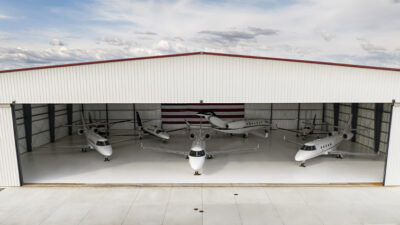Angle of Attack (AoA) Management

It’s hard to manage Angle of Attack (AoA) if the dynamic information isn’t directly available to the pilot. This is why most military and high-end commercial aircraft have incorporated AoA systems for many decades. But the vast majority of general aviation (GA) aircraft don’t yet have AoA displayed. Does this mean we haven’t been managing AoA?
The short answer is “sort of,” in that we’ve been managing our airspeed, but we haven’t been “flying” AoA – at least not directly. Indirectly, every aspect of flight involves management of the aircraft’s actual AoA. For example, Vref is the landing reference speed, which is usually the minimum recommended approach speed. Although many POHs suggested an approach speed that is a few KIAS faster than true Vref, the Vref airspeed is calculated as 1.3 times the aircraft stall speed (Vso). Stall occurs at that precise instant when the AoA is increased above the critical AoA. When flying Vref on your airspeed indicator (ASI), you are really performing at 1.3 times the airspeed that correlates to your aircraft’s critical AoA in the landing configuration, calculated for gross weight or landing weight, if calculable. Each aircraft stalls at a specific AoA, but the stall airspeed varies. So to determine Vref, we convert the stall AoA into a stall airspeed for a given configuration and weight, then multiply that value by 1.3. This alone should illustrate the potential margin for error that exists.
Another way we manage AoA without awareness of our actual AoA is when we use the flaps in any phase of flight. We extend our trailing edge flaps for takeoff, landing and slow flight maneuvers because we know that extended flaps will lower our stall speed. But what we are really doing is changing our wing’s camber. By extending the flaps we are physically and aerodynamically increasing the camber and the area of the wing, thereby producing more lift at the same AoA.
Yet another way we manage AoA is with trim. We trim our aircraft for a certain AoA, but we think of it as trimming for airspeed.
In fact, the most basic way we manage AoA is with the elevators. Without direct AoA awareness, we tend to think that we are increasing lift when pulling back on the yoke/stick and decreasing lift when pushing forward. But that is an incomplete picture and can be fraught with danger. Just imagine that we are in level flight and want to climb without adding power. We pull back on the yoke or stick and climb because we get an instant increase in lift. Keep increasing our pull and we’ll get more lift. But if we keep increasing the pull, we all know what happens next: lift goes away, probably abruptly, as we continue to pull past the critical AoA and the wing stalls. We can keep pulling back (not advised) and further decrease lift, but our AoA will continue to increase. Pulling the stick back will always increase AoA, even when the wings are stalled.
The problem is that since AoA information is not directly displayed to most of us right now, our AoA awareness is essentially nonexistent even though we are really manipulating AoA the entire time we are at the controls. Wouldn’t our AoA be easier to manage if we were constantly aware of it throughout the flight? And, since the stall described above can occur at a variety of airspeeds but at only one specific AoA, wouldn’t it be nice to know what the real AoA is, especially during critical phases of flight? The FAA thinks so.
The FAA has streamlined the process to install aftermarket AoA systems in GA aircraft1, and now strongly advocates that the GA community should use AoA-based systems to reduce the risk of an inadvertent stall, and that flight schools should develop and integrate AoA-based systems into ground training, flight training and academic education programs2.
Of course, AoA systems will never replace the ASI as the primary instrument. While AoA is the only way for us to measure the aerodynamic health of our wing, it can’t tell us when we are above gear or flap speeds, or where we are in relation to Vne. Besides, we need to know our actual air speeds in order to know that our AoA indicators are correctly calibrated for our specific aircraft. However, flying with an AoA indicator will make us better and safer pilots. Not only can we optimize our performance, we’ll be less likely to enter an upset condition, and if upset is encountered, much more efficient in the recovery. For example, “unloading” is a critical component of every upset recovery technique. By unloading, we are trying to clear the stall from the wing. Since unloading is really decreasing the AoA below the critical AoA, we would be able to see the AoA progress into the safe range, removing guess work and delays in recovery.
AoA indicators are coming, and I can’t wait. Safe flying!
Resources
1 AIR100-14-110

Prevailance Aerospace is a UPRT provider that has been working with corporate, government, and general aviation pilots to improve safety in the aviation industry. Prevailance Aerospace uses Extra 300 Series Aircraft for training and our pilots are experienced aviation professionals from various military and general aviation backgrounds. We know that successful aviation endeavors are accomplished through an uncompromising commitment to safety, impeccable professionalism, tremendous attention to detail, and constant improvement.
http://prevailanceaerospace.com
© 2025 Prevailance Aerospace. All Rights Reserved.
Next ArticleRelated Posts

Navigating Geopolitical Uncertainty Using Business Aviation
Bigger business jets mean bigger fuel tanks, longer trips, more border crossings, and bigger wallets! With an equipment upgrade also comes the requirement for a knowledge upgrade.

Leadership, Accountability and Your Organization’s Risk Profile
Recent media attention has cast light on the unusual number of aviation system-related accidents, incidents and near-misses that have plagued our industry over the past several months.

